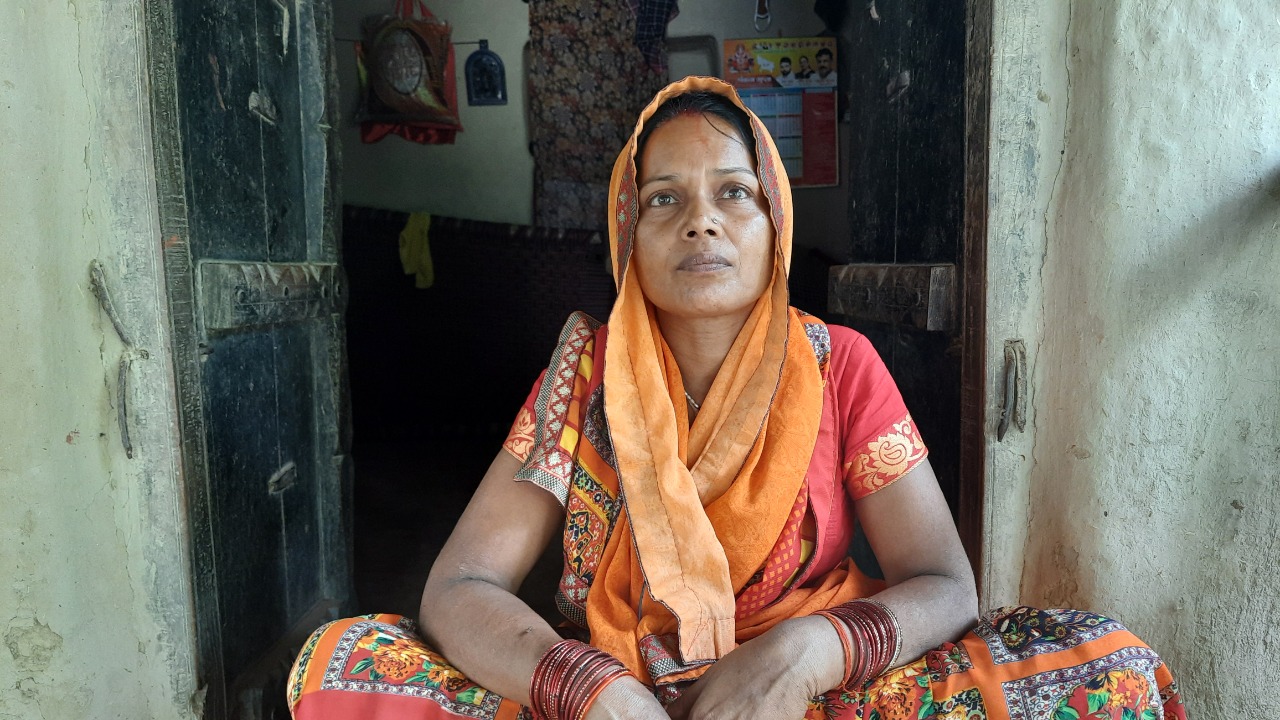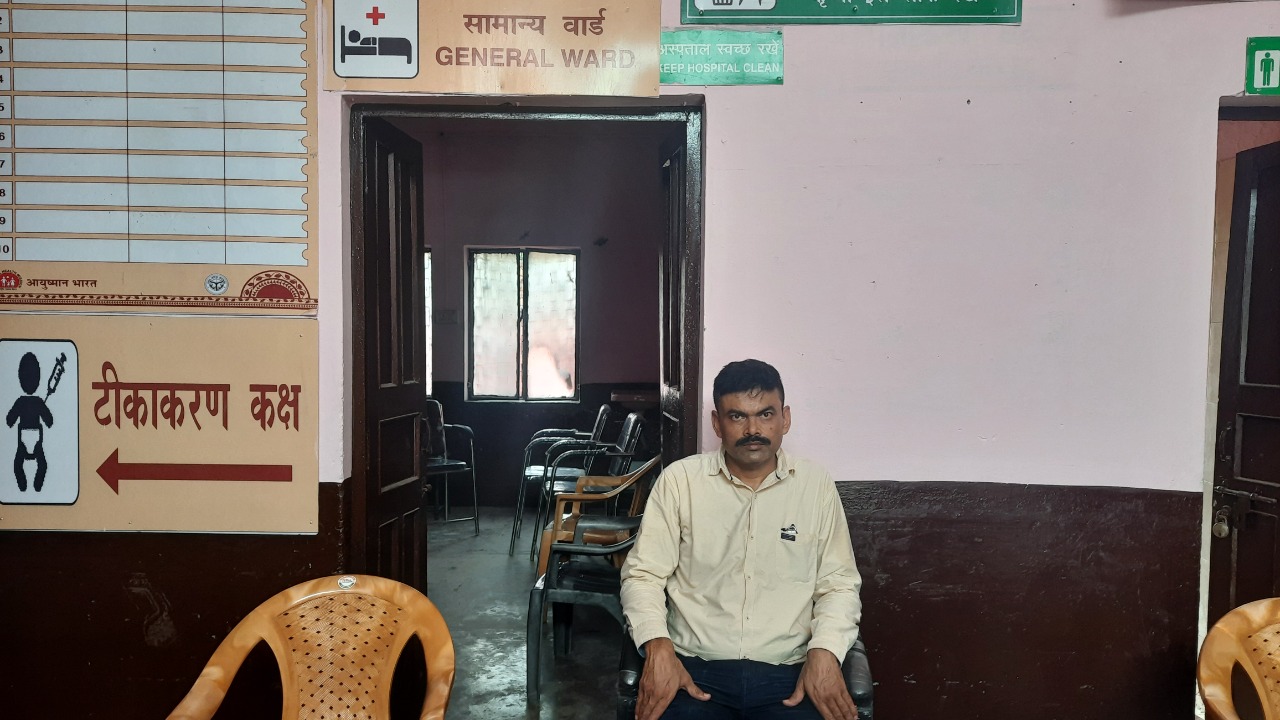The virus aside, it was the lack of information about COVID19 that killed many in the second wave in rural India
When the second wave of the COVID19 pandemic hit India, the daily fatalities ran into thousands. Rural India bore the brunt of it. What made it worse was the absence of credible information about the disease, both with the villagers and the overworked frontline health workers. A two-part Gaon Connection report from rural Unnao in Uttar Pradesh.


Archana Mishra holds a picture of deceased Gopal Krishna Mishra and their daughter. All photos: Aishwarya Tripathi
Hafizabad (Unnao), Uttar Pradesh
The wooden door was kept wide open, like most others in the village. On the front porch of Gopal Krishna Mishra’s home, in Hafizabad, Unnao, red plastic chairs were stacked on one side along with folded tables piled one on top of another; a dusty shamiana hung on a clothesline.
Mishra’s wife, Archana, had her head covered with her sari pallu and she wore red bangles. “I still cannot understand what happened in the four days between April 22 and 26,” the 40-year-old widow told Gaon Connection, grief writ large on her face.
“He had a cough with fever for two days accompanied by loose motions and breathlessness,” Archana recounted. His oxygen level was low but he wasn’t able to get oxygen at the Unnao district hospital, she continued, her eyes welling up. Mishra died at home on April 26.
Also Read: With no tests and no treatment, people in rural India are dying of COVID-like symptoms

According to Archana, no one in her family knew that COVID19 attacked the lungs. Had she known, she said, she would have rushed her husband much earlier to the hospital. She never dreamt her husband was so critically ill. After all, he was only 42 years old and it was just a cough, added.
This is not an isolated instance where the family of the deceased had little idea how devastating COVID19 could be. Across rural Unnao, families who lost a member in the second wave of the pandemic said they had no information about the virus in order to respond to the crisis. The virus aside, it was also the lack of information about the disease that led to high casualty in rural India.
While ‘oxygen emergency’ was declared in the national capital Delhi and urban populations across India put out SOS calls on social media about oxygen and availability of beds in hospitals, there was an information blackout in the rural parts of the country, even after an entire year of the pandemic. It was incomprehensible to people in villages how a seemingly common ailment of cough, cold and fever could take away a life.
Also Read: ASHAs brave the second wave of COVID19. Without masks, sanitisers and rightful remuneration
Even the frontline health workers, such as the Accredited Social Health Activist (ASHA) workers, were not properly briefed or trained to respond to emergencies arising out of the COVID19.
“The ASHA bahu wasn’t aware about the oximeter [pulse oximeter is used to measure oxygen level in blood] and the use of it. How could she, when even the doctors at the Primary Health Centre were not measuring oxygen levels,” asked Ashutosh Bajpai, the newly elected gram pradhan of Hafizabad village. “Nearly eighty per cent of the houses in the village reported fever during the second wave,” informed the 30-year-old gram pradhan told Gaon Connection.
The surprises of the second wave
Asha Sharma has been the only ASHA bahu in Hafizabad village since 2006 for a population of about 1,500. She told Gaon Connection that she was over-burdened, had neither enough masks nor any specialised training, to help her deal with the second wave of the pandemic.

Like her, over a million ASHA workers across villages, who are foot soldiers and form the backbone of the rural healthcare system in the country, were unprepared for the speed and deadly nature of the coronavirus as it swept across their villages taking lives. They put their lives at risk as they oversaw government programmes in villages and spread awareness about the coronavirus and encouraged villagers to step forward to be vaccinated.
Pointing to a box with an oximeter and a contactless thermometer, Asha Sharma said, “We received this in the first week of June, much after the peak of the second wave.” She said she had no training and struggled handling both the oximeter and the thermometer, calling them “complicated”.
“How will they know how to use an oximeter if they have hardly practised it? They have had basic training, but handling unfamiliar gadgets efficiently requires time,” Upendra Singh Chauhan, health education officer at the Sikandarpur primary health centre (PHC) in Unnao, told Gaon Connection.

Chauhan heads 193 ASHAs and acknowledged that the ASHA workers did have the problem of limited information about the requirement of oxygen to treat COVID19 infections. He also added that there were a total of six oximeters in each PHC serving an entire block and these were reserved for “special field visits”.
However, Narendra Singh, district immunisation officer, Unnao dismissed claims that there were not enough pulse oximeters in PHCs. “Every village was provided with oximeters and the ASHAs should not be blaming lack of training and equipment,” Singh told Gaon Connection.
Dependence on jhola chaaps
Amid the second wave and a lack of information about the disease, there was general distrust and fear of the government hospitals. Rural inhabitants preferred to see the local jhola chaap (rural medical practitioner) ‘doctors’. Considered to be quacks by the educated world, these ‘doctors’ have nevertheless been part and parcel of the rural landscape for years.
“These doctors we refer to as jhola chaap so disparagingly, are the ones who cured eighty per cent of the infected villagers. People queued up at their clinic for hours as no one wanted to risk the government hospital,” gram pradhan Bajpai told Gaon Connection.
Also Read: “I may be a jhola chaap, but I help villagers in their times of distress”
When 60-year-old Shashi Ram Tiwari’s nephew Shiva Shukla complained of “extreme breathlessness”, he was taken to a jhola chaap ‘doctor’, Razzaq, who Tiwari said, has been treating the family for as far back as he could remember.

“Jhola chaaps are available to the village inhabitants all day long. If someone falls ill on a Sunday, where will they go? The PHCs are shut,” health education officer Chauhan told Gaon Connection. “Currently, we (government) haven’t established a healthcare system that is easily accessible. If we want to address the problem of jhola chaap treatments, we need to first strengthen healthcare at grassroots level,” Chauhan emphasised. He pointed out that while each village had two to three jhola chaaps, there was just one government hospital that is 20 kilometres away.
Fear factor and rumours
One of the main reasons for the reluctance of villagers to show themselves at the government hospitals and dispensaries was the fear that they may be quarantined, and not allowed to meet family members. Worse, they knew of many cases where the body of the deceased family member was not handed over for cremation. Many villagers could not forget how migrants returning to the village during the first wave were forcefully taken away to quarantine in unfamiliar places.
“They were wrapped up in momiya (PPE suits), and taken away against their wills,” 61-year-old Md Ehsaan recounted to Gaon Connection with a shudder. This fear of being separated from family drove many people to hide their COVID19 symptoms from the administration, as well as ASHA bahus.

Even when the 10-member Sonkar family in Hafizabad had people down with joodi-bukhar (fever with shivering), they did not go to the hospital. Instead, they put their faith in two local doctors “whose medicines seemed to work”.
Meanwhile, there were strong rumours in villages where people believed that the COVID19 vaccination could cause death. In fact, Gopal Krishna Mishra and his mother Shashi Mishra had both been vaccinated. Two days after her son died, 70-year-old Shashi passed away too, further fuelling fears amongst the village inhabitants on getting inoculated.
Also Read: COVID19 in rural India: Shortage of PHC doctors, preference for quacks and high vaccine hesitancy
While people in rural India died in the second wave of the pandemic, deaths still remained a social event where many gathered to pay their last regards to the departed soul. The idea of distancing oneself from a sick person sounded insensitive to most of the village inhabitants. The rural community is a close knit one that strongly believes in ache-bure waqt ka sath (being there for one another in good times or bad).
Aishwarya Tripathi is an independent journalist based in Unnao, Uttar Pradesh. This story was reported under the National Foundation for India fellowship for Independent Journalists.
The second part of this series revolves around innovative communication methods to foster trust amongst the rural community that thinks very differently from its urban counterpart.

